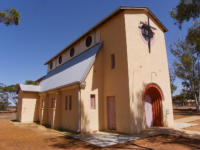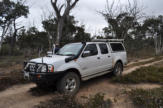
Grey Gypsies of Australia
Western Australia - 2010
Local information from the Information Centre at Three
Springs suggested that the Leschanaltia Macrantha could be
found flowering round Perenjori and Morowa and that the
Perenjori caravan park was the best place to stay in the area,
although we later saw the Morowa caravan park and thought it
quite good also. On the trip over to Perenjori we failed to find
any examples of the plant from the vague directions we had
been given but got much better information from the Perenjeri
Information centre. A large colony of the plants had been sighted along Cunningham
Rd that could be reached by detouring off the Perenjeri/ Morowa Rd. Our trusty GPS took us off on a few dusty
tracks and eventually we found the colony of around 100 plants of all sizes, many in full flower. I photographed
every plant in the colony which was spread out along the road verge over a distance of about 100 meters. A
further smaller group was about 300 meters further down the road. Over the next week we found two more
large colonies of the plant, one of 200 plants down the main Perenjori/Morowa road and the third of 300 plants
along Bateman Rd. In all cases the plants had sprung up along road verges recently disturbed by either road
grading or fence making. It appears their seeds live in the soil for long periods and emerge after rain in Spring
when the ground is disturbed. This explains their elusive appearances and disappearances two to three years
after they are first sighted in a spot. Other wild flowers were growing amongst the wreath flowers in the two
latter colonies. These included plants that were related to the leschenaultias: blue Scaevola albida; blue
dampieria; and yellow goodenia. "
The mystery was what fertilized the flowers to start seed production. We assumed it was bees after seeing
several types of native bee visiting the flowers, but a further trip back to consult
Alan Tinker convinced us that it was likely to be a small honeyeater that picked up
the pollen on its forehead from the unusual stick like anther that emerged from each
flower head.
Although we spent quite a lot of time visiting, photographing and observing these
plants we had time for other activities as well. The local pub was worth a visit for a
meal and the ladies at the Perenjori Information Centre did
a great Devonshire tea. We drove the wide open wheat-
lands landscape on a number of days and stopped to picnic
or to give me time to sketch the rolling hills and crop patterns. Morowa had some
interesting buildings including a catholic church designed by Monsignor Hawes with its
typical Spanish Mission influence but we were not able to see inside it. Perenjori also
had a Monsignor Hawes church, but with fewer Spanish Mission features. This area is
right in the middle of the Monsignor Hawes cultural trail as he designed many of the
church buildings in the wider district in the early twentieth century. None that I have
seen so far have compared with his own small church and priest's
house in Mullewa that he built with his own hands and are lovingly cared for by local
parishioners, including the beautiful garden of palms, oleanders and bougainvillea.
We also got copies of several four wheel drives in the district, again from the ever helpful
Information Centre. Our favorite was the drive out to the old copper mining town of
Rothsay, now abandoned. The drive took us through private property on the old Rothsay
coach road. It was a golden afternoon as we drove through hilly wild flower country with
long shadows cast by the trees. There are lots of good camp sites along the way, as long as you get permission.
Rothsay still has a lot of mining infrastructure left including a large open cut
pit that is fenced off.
We also drove out to the old Boida campgrounds where sheep mustering still
takes place. A camp kitchen and a shower block are quite functional but not
very pleasant to use. Several groups were camped there: not a place to camp
alone and ponder the beauties of nature. We left the other tracks for a later
visit to this area, but need better local maps with all the tracks marked [1:50,000]. Most of the tracks take you
up off the lowlands and into the rolling hills to the east.
Most striking in this area is the increase in recent mining activity. Many small mines are
operating and the local small towns are becoming accommodation centers for the mine
workers. Demountable cabins provided by particular mines are being erected in large
clusters to house workers. One such cluster was neatly arranged beside the Perenjori
caravan park and cared for by the managers of the park. Another was being negotiated
with the local council on a different site, also to be serviced by the park managers. Lots of
casual work seems available and often taken up by travelling retirees with their own
caravans: managing caravan parks, working at the wheat receiving silos in season,
working in shops and pubs and other more specialized work for older skilled workers.









Grey Gypsies of Australia
Western Australia - 2010
Local information from the
Information Centre at Three Springs
suggested that the Leschanaltia
Macrantha could be found flowering
round Perenjori and Morowa and that
the Perenjori caravan park was the
best place to stay in the area,
although we later saw the
Morowa caravan park and
thought it quite good also. On
the trip over to Perenjori we
failed to find any examples of
the plant from the vague
directions we had been given
but got much better information from the Perenjeri
Information centre. A large colony of the plants had
been sighted along Cunningham Rd that could be
reached by detouring off the Perenjeri/ Morowa Rd.
Our trusty GPS took us off on a few dusty tracks and
eventually we found the colony of around 100 plants of
all sizes, many in full flower. I photographed every
plant in the colony which was spread out along the
road verge over a distance of about 100 meters. A
further smaller group was about 300 meters further
down the road. Over the next week we found two more
large colonies of the plant, one of 200 plants down the
main Perenjori/Morowa road and the third of 300
plants along Bateman Rd. In all cases the plants had
sprung up along road verges recently disturbed by
either road grading or fence making. It appears their
seeds live in the soil for long periods and emerge after
rain in Spring when the ground is disturbed. This
explains their elusive appearances and disappearances
two to three years after they are first sighted in a spot.
Other wild flowers were growing amongst the wreath
flowers in the two latter colonies. These included plants
that were related to the leschenaultias: blue Scaevola
albida; blue dampieria; and yellow goodenia. "
The mystery was what fertilized the flowers to start
seed production. We assumed it was bees after seeing
several types of native bee visiting the flowers, but a
further trip back to consult Alan Tinker convinced us
that it was likely to be a small honeyeater that picked
up the pollen on its forehead from the unusual stick
like anther that emerged from each flower head.
Although we spent quite a lot of time visiting,
photographing and observing these plants we had time
for other activities as well. The local pub was worth a
visit for a meal and the ladies at the Perenjori
Information Centre did a great Devonshire tea. We
drove the wide open wheat-lands landscape on a
number of days and stopped to picnic or to give me
time to sketch the rolling hills and crop patterns.
Morowa had some interesting buildings including a
catholic church designed by Monsignor Hawes with its
typical Spanish Mission influence but we were not able
to see inside it. Perenjori also had a Monsignor Hawes
church, but with fewer Spanish Mission features. This
area is right in the middle of the Monsignor Hawes
cultural trail as he designed many of the church
buildings in the wider district in the early twentieth
century. None that I have
seen so far have compared
with his own small church
and priest's house in Mullewa
that he built with his own
hands and are lovingly cared
for by local parishioners,
including the beautiful garden
of palms, oleanders and
bougainvillea.
We also got copies of
several four wheel drives in
the district, again from the
ever helpful Information
Centre. Our favorite was
the drive out to the old
copper mining town of Rothsay, now abandoned. The
drive took us through private property on the old
Rothsay coach road. It was a golden afternoon as we
drove through hilly wild flower country with long
shadows cast by the trees. There are lots of good camp
sites along the way, as long as you get permission.
Rothsay still has a lot of mining infrastructure left
including a large open cut pit that is fenced off.
We also drove out to
the old Boida
campgrounds where
sheep mustering still
takes place. A camp
kitchen and a shower
block are quite functional but not very pleasant to use.
Several groups were camped there: not a place to
camp alone and ponder the beauties of nature. We left
the other tracks for a later visit to this area, but need
better local maps with all the tracks marked
[1:50,000]. Most of the tracks
take you up off the lowlands and
into the rolling hills to the east.
Most striking in this area is the
increase in recent mining activity.
Many small mines are operating
and the local small towns are
becoming accommodation centers for the mine
workers. Demountable cabins
provided by particular mines are
being erected in large clusters to
house workers. One such cluster
was neatly arranged beside the
Perenjori caravan park and cared
for by the managers of the park.
Another was being negotiated
with the local council on a
different site, also to be serviced
by the park managers. Lots of casual work seems
available and often taken up by travelling retirees with
their own caravans: managing caravan parks, working
at the wheat receiving silos in season, working in
shops and pubs and other more specialized work for
older skilled workers.








Copyright Grey Gypsies Australia 2009
Copyright Grey Gypsies Australia 2009


































